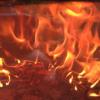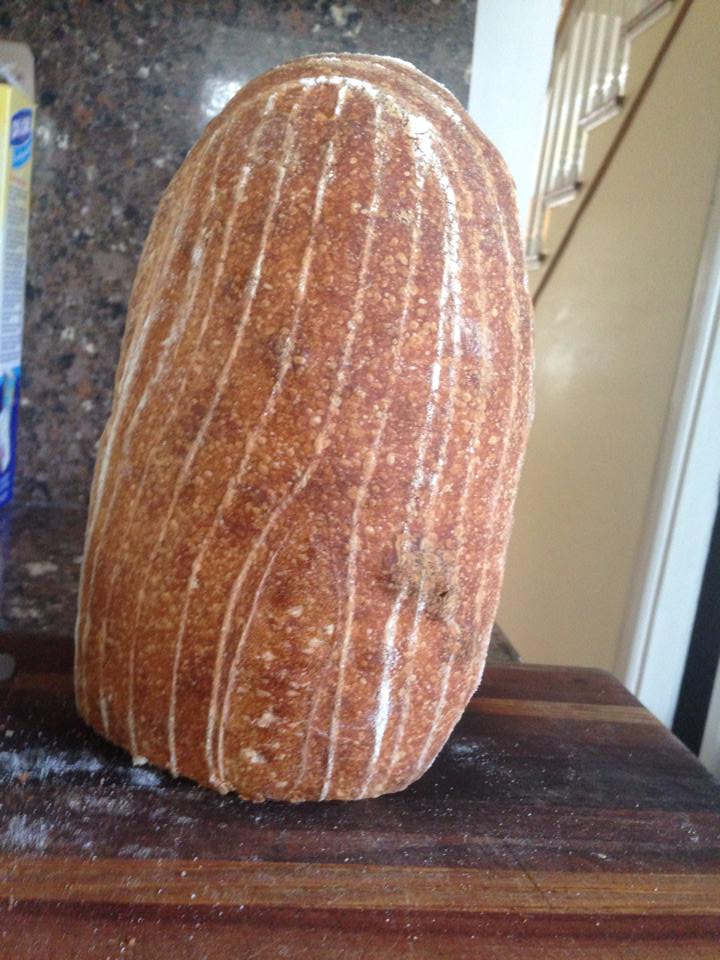
Tartine Experiment

Well, this time around, I pre-heat the oven to 500 and then, accidentally, when it was time to bake I "lowered" the oven to 550. I realized the error of my ways when I lifted the top off the combo cooker and saw that the loaf had started to caramelize on top. Actually, I didn't quite realize it then, though I should have. It took me until I finished the last of my waffle to notice that the oven was on 550, at which point I lowered it to 400 and then a few minutes later, I lowered it to 350. I took the loaf out a few minutes "early" and it looked like this:
I also made a batard with the other half of the dough. The dough had stuck to the brotform a bit, causing it to stretch a bit in height. I did try scoring but you wouldn't know it... I cooked it in the turkey roaster. It was a little pale after 40 minutes, so I took it out and put it on my cast iron pizza pan that resides in my oven, and cooked it for another 2 minutes.

And the crumb on the batard is delicious as is the crispy crust. I have to say that paying attention to temperature seems to make all of the difference. This dough stayed at 75-80 degrees through the 4 hour bulk rise, and was retarded overnight (from 2pm till 8:30 am) and baked right out of the fridge this morning. Still slightly warm when I cut into it, and quite divine.




But I like the too-hot boule better, though I'm sure both are delicious.
I have had similar Larry David moments with my oven temperature, but usually turned it off too early or set the temp too low. Though once baking a challah with 11% sugar I did set it too high and it burned considerably. Still ate it, just cut the crust off each slice.
I agree, the boule looks better. However, I do love how easy it is to make a sandwich out of the batard. And it was super soft with a thin crisp crust. So it is a real pleasure to eat. I had to cut it open even though I have half a boule sitting in my bread box. Maybe I will make french toast out of that one...
and the crumb of the batard is great - but guess the boule crumb is even better? Werll done and
Happy Baking
I will have to wait on the boule crumb. Normally that boule is pale as can be when I take the cover off after 20 minutes. This time it was brown and slightly burned on the ear. It is good to know that the bread can be saved even when it starts out at too high a temperature.
I did use the wire rack inside the roaster, and put one piece of parchment paper between it and the dough. The underside of the batard has grill marks, which make it easy to slice the bread. :)
The bread is a bit pale on the bottom. I believe the only reason it browned at all is because when I took it out of the roaster I placed it onto the cast iron pizza pan for a couple of minutes.
browned next to the hot metal.
What about setting the pale loaf to brown on an oven rack without any pans. Might get a more even browning and less burning from too hot a metal. Or was the oven so hot that the oven rack would have burnt in rack lines? Perhaps the roaster is sitting too high in the oven. I prefer more heat under the loaf in the beginning of baking for more spring.
Crumb shot indicates more heat on the top of the loaf than the bottom. This would leave the top crust to set up early and limit upward expansion.
You are the one I refer to as the crumb detective!
I may have used the cast iron pan instead of the rack because I wanted to brown the bottom. I just didn't realize how quickly that would happen, nor did I realize that there was an uneven bottom surface that would cause grill marks.
It was baked on the middle rack, however, I believe that the roaster top was preheated and the bottom was not. That would probably account for the top being hotter than the bottom? You can tell this because their are more holes up top than on the bottom?
You can tell this because there are more holes up top than on the bottom?
That and thinking where is the loaf to expand if the top crust is set too early? A: the lower sides of the loaf will most likely split as gas escapes... look for the side splits (I had to look more carefully on the bottom shot) and there they are! Or are you an aggressive bread cutter? The weakness in those areas is where gas will try to escape from your loaf.
A loaf expanding downward has to lift it's own weight while it is springing and will force bubbles into rounder more horizontal shapes esp. near the bottom. Think pressing down on a balloon. Now look at the bubbles again.
I was surprised because I did score the tops, but the bottom side busted out. As this was the first time I shaped a batard, I attributed it to poor shaping technique. But I will blame the oven temperature for now.
well, the oven temp might have worked if the heat distribution was more even or reversed, more heat under the loaf than above it.
Heating the cover and not the whole pan more than likely contributed to early setting and top browning. Insulating the bottom of the loaf against the heat by raising it also added to reducing heat under the loaf, the heat would then rise inside the pan around the loaf and collect under the lid also adding to too much top heat on the loaf.
I don't have a stone. I set my roasting pan on the bottom shelf and the dough inside on parchment. I tent with two layers of foil if I don't have the cover. The darker the pan, the more it can be lifted up away from the source of heat. If the roasting pan is white, or sparkling metal, the lower the better. The whole thing goes cold into the hot oven. Ovens vary greatly and experimenting with your oven may be different than mine, you have to try stuff and see what works best for you.
When the score and the surrounding crust is the same color, more than likely, the crust set up too soon. Crust color is beautiful on top, by the way, but I had to really look for the score. I've had to really look for a lot of things lately, my eyes are getting tired. Don't ever be afraid to flip a loaf upside down in the oven when the top of the oven seems too hot late in the baking. The set crust can handle it. I've saved many an outside loaf that way, but the crumb will not change.
It is a shiny metal roaster. I will try baking with it on the bottom if I am to make a batard in a roaster again.
I have to say that the batard is a lot more practical than the boule. However, the boule is a lot more striking because it cooks up so much better in the combo cooker. I will give the batard another, remove the wire bottom and lower put it in the oven cold and on a lower shelf and see how that works.
I had thought about using my cast iron pancake griddle and just covering that with the roaster top, but it doesn't sit right. I wonder if having the bottom not "sealed" would let steam escape or if it wouldn't matter so much because the steam of the loaf rises... I expect it wouldn't work as well because there would be more hot air coming into the roaster from below.
at a time might confuse. Try using a hot oven before switching to a cold oven. (A cold oven requires less dough proofing and guarding against uneven preheating) Iron will get hotter than a stone so preheat at a lower temp than a stone.
The lid should sit right or flat, any gap lets steam out.